inside
Lessons Learned: The Legacy of Haiyan

On the morning of November 8, 2013 in Tacloban, Kent Nemenzo managed one last Facebook status update about how the winds of Typhoon Haiyan (local name: Yolanda) broke the chain holding the gates of his home together. A bit later, he noticed brackish water seeping into the sealed windows and glanced outside: The flood was chest-high, and his car was slowly floating away. “I ran over to where my family was and told them how high the water is, and how it’s still rising,” he recalls. “My mom had barely gotten out of bed when my younger sister started screaming. The door near our kitchen could no longer hold the water and the debris; it cracked open, and our house started becoming a death trap.”

An aerial shot of Tacloban after Typhoon Haiyan. Photo taken by Chris Darza, originally published in Zee Lifestyle‘s December-January 2014 issue
Everyone made it through the front door and out of the house, standing on the windowsill and holding on for dear life as the water levels continued to rise. His girlfriend lost hold of their three-year-old daughter, and he lunged after them despite not knowing how to swim, pushing them near a concrete railing where they could get a foothold. Meanwhile, his mom was swept away; she held on to one of the drainage pipes a bit further behind. Eventually, the water started going down and brought them down to ground level. “Reality started to creep in, and it wasn’t looking good,” Kent narrates. “We had nothing but the clothes on our back. Everything in the house was gone. One of our dogs went missing. But we were alive.”
As the entire world knows by now, other people weren’t as lucky. “Typhoons are a normal occurrence, and they almost always first make landfall in the Samar and Leyte area,” Kent explains. “I treated Haiyan like everyone else treated it: like a normal typhoon passing by. We never accounted for wind speed. No one knew exactly what a storm surge meant.”

Malapascua Island after Typhoon Haiyan. Photo by Chris Darza, originally published in Zee Lifestyle‘s December-January 2014 issue
One year later, yet another storm made its way to the Philippine Area of Responsibility (PAR). Typhoon Hagupit (local name: Ruby) was touted to be as devastating as Haiyan, and more worryingly so, it was also on the same path as the aforementioned super storm. Although it intensified into a Category 5 super typhoon in early December, it weakened into a Category 3 typhoon before making landfall in Eastern Samar. It progressed slowly throughout the country, with landfalls in Masbate, Marinduque and Batangas before finally exiting the PAR on December 10.
The impact wasn’t as bad as Haiyan last year. While property damages stood no chance against Mother Nature, with the National Disaster Risk Reduction and Management Council (NDRRMC) reporting a total of three billion pesos’ worth of damages in infrastructure and agriculture as of December 12, the casualties have been kept to an extreme minimum. According to NDRRMC, 19 people died—a far cry from the more than 6,000 people post-Haiyan. While the lower figures could be attributed to Hagupit weakening, a significant factor lies in the fact that people were more prepared: Classes were suspended, people fled to evacuation centers, and the Philippine government prepared rescue boats for food packs, medicines, and doctors. This time around, everyone learned their lessons.
“Yolanda has left her profound footprint on the Philippines. In all likelihood she will not be the last super-storm to bludgeon its way through our country. I shudder to think of what will happen if another angry typhoon follows on heels of Yolanda. In today’s world of mutated weather, as certain as an angry woman’s slap, another Yolanda, Ruping, Dading, Ondoy or Pepang will come. We can no longer be ill-prepared and we only have to look at how many other countries prepare for and respond to disasters: the USA, Fukushima in Japan, and even in India in 2012, where 800,000 people were forcibly evacuated following a major typhoon warning. The storm hit and only a handful of lives were lost. Seventeen years earlier, a similar typhoon hit the same area of India and 10,000 people died. They learned. They prepared. They lived. Time is short, and the waters may rise again.”
Joseph, Dondi. “Moving Forward.” Zee Lifestyle. Dec.-Jan. 2014: 80-88
According to Margareta Wahlström, Chief of the United Nations Office for Disaster Risk Reduction (UNIDSR), the Philippine government has done an excellent job of putting into action the lessons learned from Haiyan. “All arms of government, including PAGASA and the NDRRMC, and municipalities like Tacloban have pulled together to save lives and minimize the damage being inflicted by this disaster event.”
“Filipinos have learned to take this climate change seriously, and that it is best to take caution to leave their homes and evacuate to safer structures,” says LA-born designer Renée Patron. Although she survived the destructive effects of Haiyan when she was in her hometown of Guiuan, Eastern Samar, it took a while for her business to get back on the ground. A profile on Renée in Zee Lifestyle’s Dec.-Jan. 2015 issue details how Haiyan destroyed the entire production of her business, Banago, a collection of bags and home accessories hand-woven from the banig by women from Samar. “In the blink of an eye, our homes, our towns, our natural materials, our production facility—close to half a million dollars in production—were all taken by the storm surge and typhoon,” she reminisces.

Mats used to make Banago products damaged after Typhoon Haiyan. Photo taken from Renee Patron of Banago
In September this year, a Kickstarter campaign by Banago and Livelihood United raised $20,000 to help restore the livelihoods of over 400 women in Samar. In the light of Hagupit, Renée shared that the typhoon did not cause that much damage this time around. “We made sure all the finished products and machines were kept in a safe place this time,” she shares. “We made sure all the supplies—gadgets, first aid kits and food—were at hand and in a place where it would be kept dry.” Her experience with Haiyan taught her which kinds of structures were safe, in case of strong winds or flooding. “We went the extra mile to make sure we could survive another super typhoon.”

Guiuan, Eastern Samar, where Banago produces its bags and home accessories, left in a wreck after Typhoon Haiyan. Photo taken by Chris Darza
Following Haiyan, Kent moved to Manila, yet the ghosts of the storm continued to haunt him. “I didn’t get enough sleep when Hagupit was making its way to the Visayas,” he admits. “Thankfully, no storm surge—just a bit of damage on the outside of the house, but we still had a roof.”
“Everyone was better prepared, but mostly because everyone experienced the worst and didn’t want to go through the whole thing again,” Kent says. He believes that Filipinos now have a better idea about storm categories, speed, storm surges, and the importance of climate change. While typhoons before averaged 160-180 KPH; now it looks like typhoons above 200 KPH are the norm.
“We’ve learned to heed calls for evacuation—to take the information they see on weather bulletins seriously,” he adds.
Haiyan was a shadow that loomed over Hagupit, especially with such a short span of time between these two storms. “Make no mistake. It may take only weeks or months to rebuild homes, but it will take years to replace lost livelihoods and to heal hearts torn apart by loss,” Dondi Joseph writes in ‘Moving Forward’, the cover story for Zee Lifestyle’s Dec.-Jan. 2014 issue post-Haiyan. “We must never forget Yolanda—not only for the sake of those who suffered, but for the sake of those who survived and still live in the peril of more catastrophes—as we all do,” his article continues.
Haiyan and Hagupit weren’t the first, nor will they certainly be the last. As Dondi states in his article, “Through the devastation, the human spirit is battered but not broken.” All the more, while the world praised the resiliency of the Filipinos, the lessons brought forth by Haiyan are ultimately its legacy to our countrymen.
This story is an update on Typhoon Hagupit, as well as a follow-up to Dondi Joseph’s ‘Moving Forward’, the cover story for Zee Lifestyle’s December 2013-January 2014 issue.
inside
Butch Carungay’s 50th in Neverland

By Emmanuel Hamoy
Cebu’s glitterati came out in full force for Butch Carungay’s 50th birthday bash at EdenClub. It was a fun-filled night overflowing with Pol Roger, trivia games whilst traipsing the light fantastic.


Butch Carungay and Janice Lin.

Gerry Laperal and Lotte Delima-Edwards

Romero Vergara and Oj Hofer

Mary Anne Aboitiz, Christine Pelaez, Tamsin Booth, Frances Siao and June Alegrado

Maris Holopainen and Carlo Cordaro

Janine Taylor and Mary Anne Aboitiz
Fashion
Lucky Colors of 2025: Harness the Energies of Emerald Green & Carmine Red for Success

by Oj Hofer
With the Year of the Wood Snake underway, understanding the significance of lucky colors can help align us with its energetic flow. Rooted in Chinese astrology and Feng Shui, the year’s fortifying shades—emerald green and carmine red—offer mindfulness and good intention attracting luck, and fostering personal growth.
Emerald green, associated with the Wood element, symbolizes renewal, clarity, and inner peace. In the year of the wood snake, its dynamic energies will empower and inspire you, fostering growth, renewal and wise transformations. The hue is ideal for moments of self-reflection, study, or creativity. Wearing or incorporating this shade into your space enhances balance and mental focus.
Carmine red, linked to the Fire element, embodies passion, confidence, and vitality. This year, which according to the Bazi Four Pillars Chart, has a lack of metal, earth and fire elements, it will bring balance and the propitious energies. It’s perfect for professional meetings, decision-making, and moments requiring assertiveness as a splash of red can energize and embolden you throughout the day.
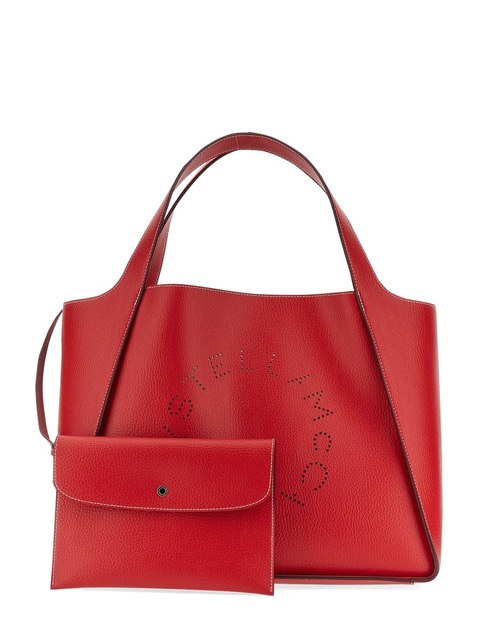
Stella Macartney vegan Leather tote
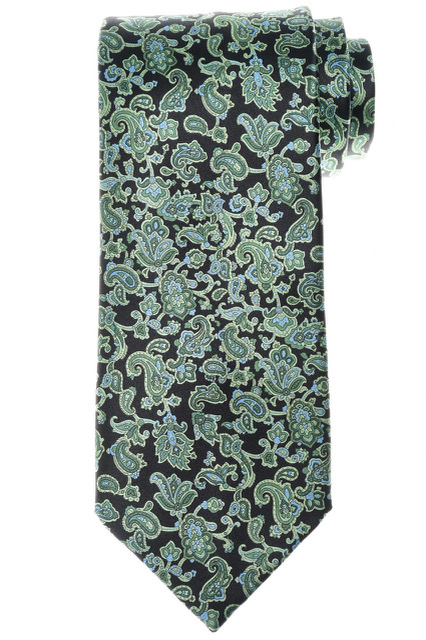
Stefano Ricci silk tie with paisley print
To fully harness their benefits, use these colors in a contemporary, mobile context; through clothing, jewelry, bags and accessories. Alternate between these two potent tints based on your needs. For example, wear green for calmness and clarity when you are going into stressful and mind challenging meetings or appointments. Choose red when you are going into places or situations where you need courage and motivation such as fashion galas, elite socials, prestige affairs, VIP gatherings and so forth.
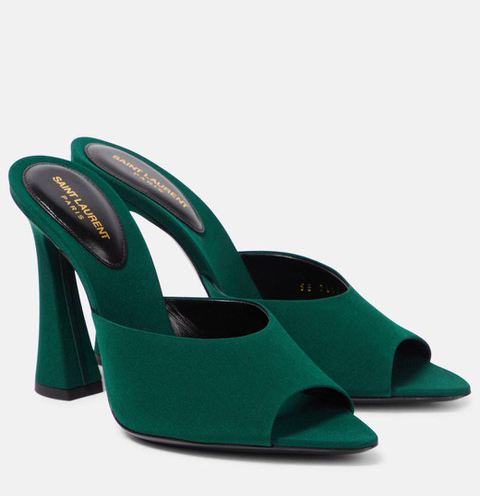
Saint Laurent crepe de chine mules
Optionally, you can also choose to wear these colors inconspicuously in small details, such as a garnet or jade bracelet, or a ruby or emerald pendant and earrings set. Men can wear a burgundy or forest green tie or pocket square, or casual polo shirts with poppies or with botanical prints, or jade and garnet jewelry. Doing so can subtly align your energy with the year’s vibrational flow.

Jan Leslie emerald bracelet

Daily Mood Cuff Links with red tiger’s eye tubes
The use of colors is more than just aesthetic choices or preferential picks. Colors can serve as energetic tools, reminding you of your good intentions and keeping you mindful of you daily motions. Effecting an optimistic mental state in the wearer, they can effectively shield you from negativity while fostering prosperity and emotional balance. Thoughtfully incorporating them into your wardrobe and surroundings ensures that you move through 2025 with confidence and the right intentions.
Embracing emerald green for tranquility and carmine red for strength are intentional, mindful choices that have the power to transform your energy and shape your path forward. May you have the best of luck in navigating through Year of the Snake with harmony, energy, and the power to attract good fortune.
inside
The Java Jive

by Janine Taylor
“Coffee is more than just a drink; it’s something happening. Not as hip, but like an event, a place to be, but not like a location, but somewhere within yourself. It gives you time, but not actual hours or minutes, but a chance to be, like be yourself, and have a second cup.” — Gertrude Stein, American novelist and poet
Coffee, that magic potion in a cup, is our morning savior and the fuel that helps us get through the day. Whether you’re a stickler for the classics and prefer an espresso or need to start your day with some café au lait or a cappuccino, and yes, we live in the tropics, so iced coffee is good too, we all need our caffeine fix!
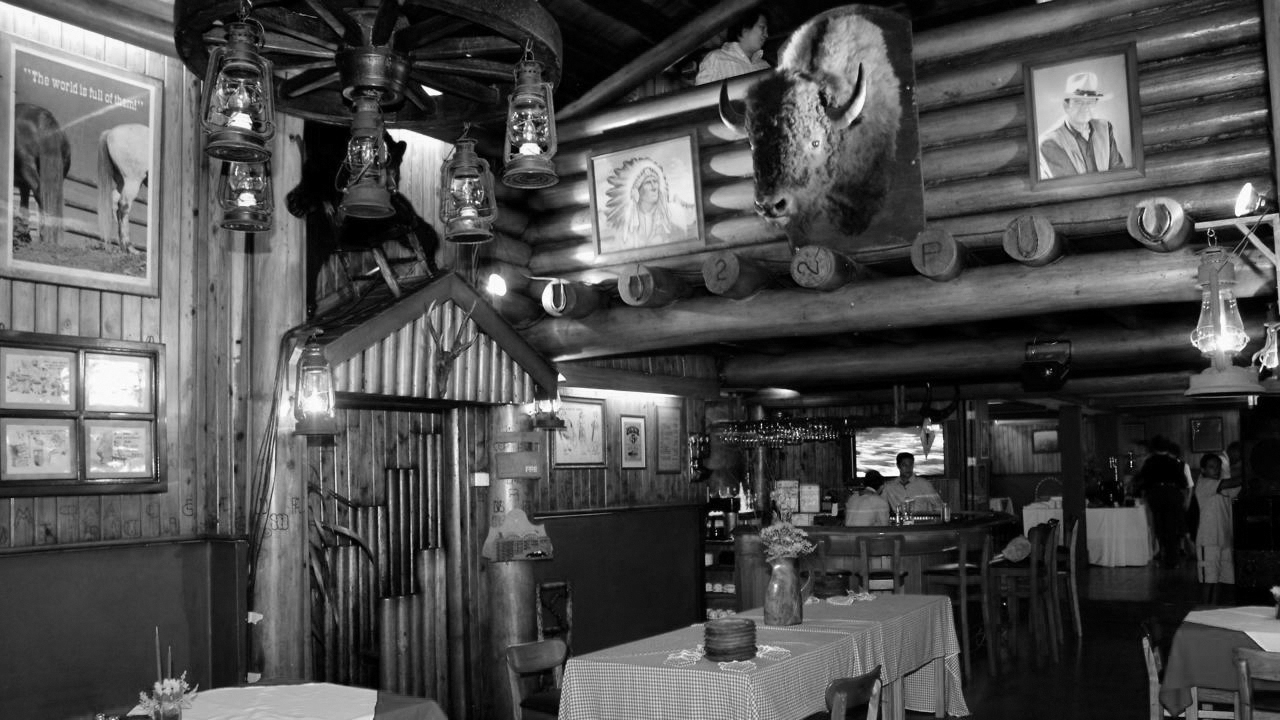
The interiors of Eddie’s Log Cabin
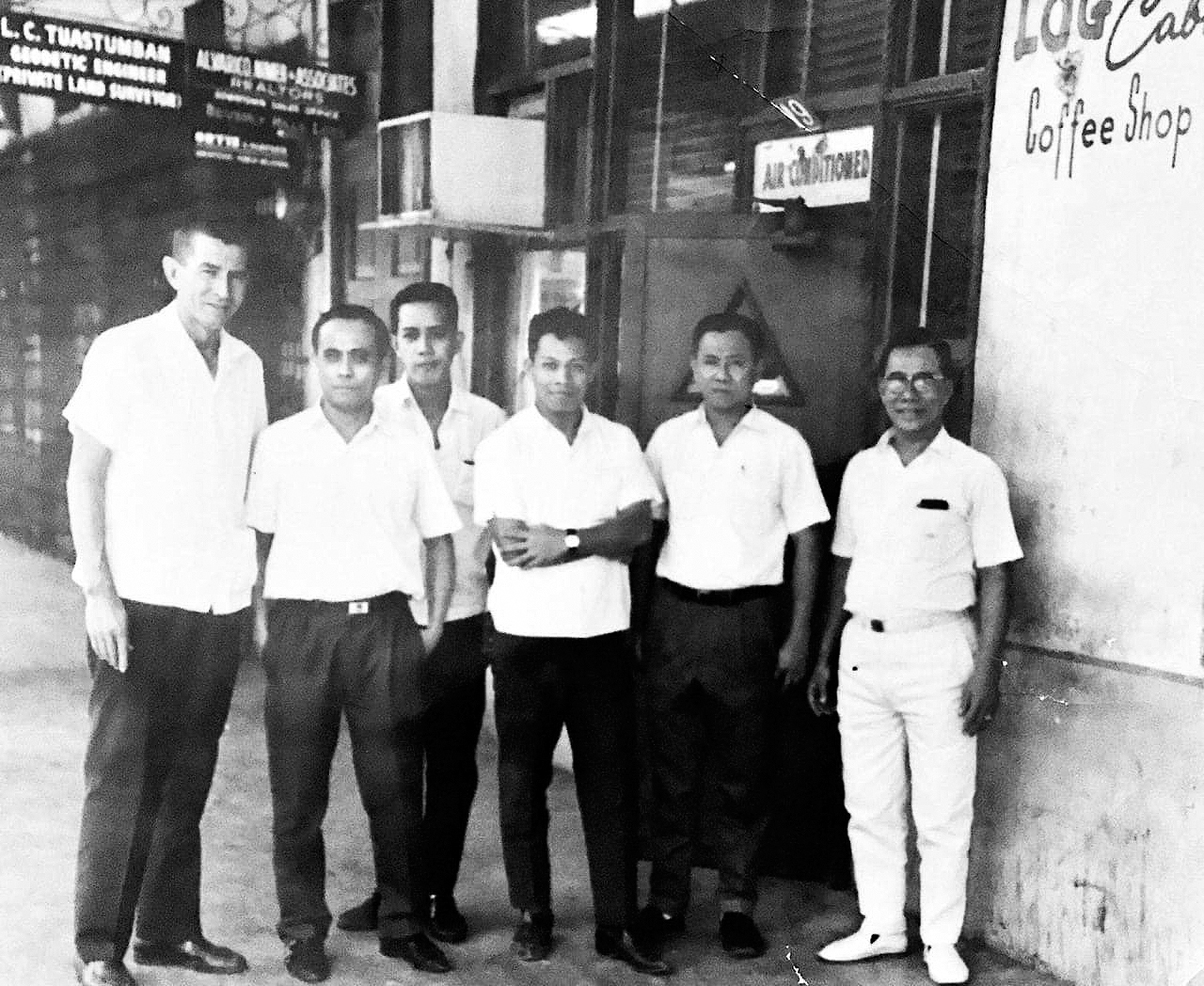
Eddie Woolbright with the original waiters of Eddie’s Log Cabin
Growing up in Cebu decades ago, our earliest memories of coffee were the aroma wafting from the percolator at Eddie’s Log Cabin as soon as you opened the doors. You then stepped in for a cup of Joe and a slice of pie. For our parents’ generation, the ultimate sophistication was a cup of “brewed coffee” because, at home, it was freeze-dried instant coffee with powdered creamer and sugar. Folgers was the coffee of choice. Hyperacidity in a cup when you think about it!
Starbucks descended on our shores in December 1997, and our vocabulary suddenly expanded with venti, grande, and Frappuccino. People were willing to pay exorbitant amounts for a cup of coffee. But more than that, it was an experience. It was, all of a sudden, the place to be seen. It was trendy to have coffee at all hours of the day and not just for breakfast.
Cafes have now become the place to meet up with friends, a venue for meetings, and even a space to work from, and you don’t have to be a digital nomad. You can get caffeinated in air-conditioned comfort with WIFI and a snack.
“Seattle has unleashed this weird phenomenon called the coffee shop on the world. And the coffee shop, thanks to Starbucks, is the place where socially isolated, lonely, needy people gather together to ignore one another.”
— Mark Driscoll, American author
Armed with the adage that you can never have too much caffeine, we spent an afternoon visiting three great joints in the city.
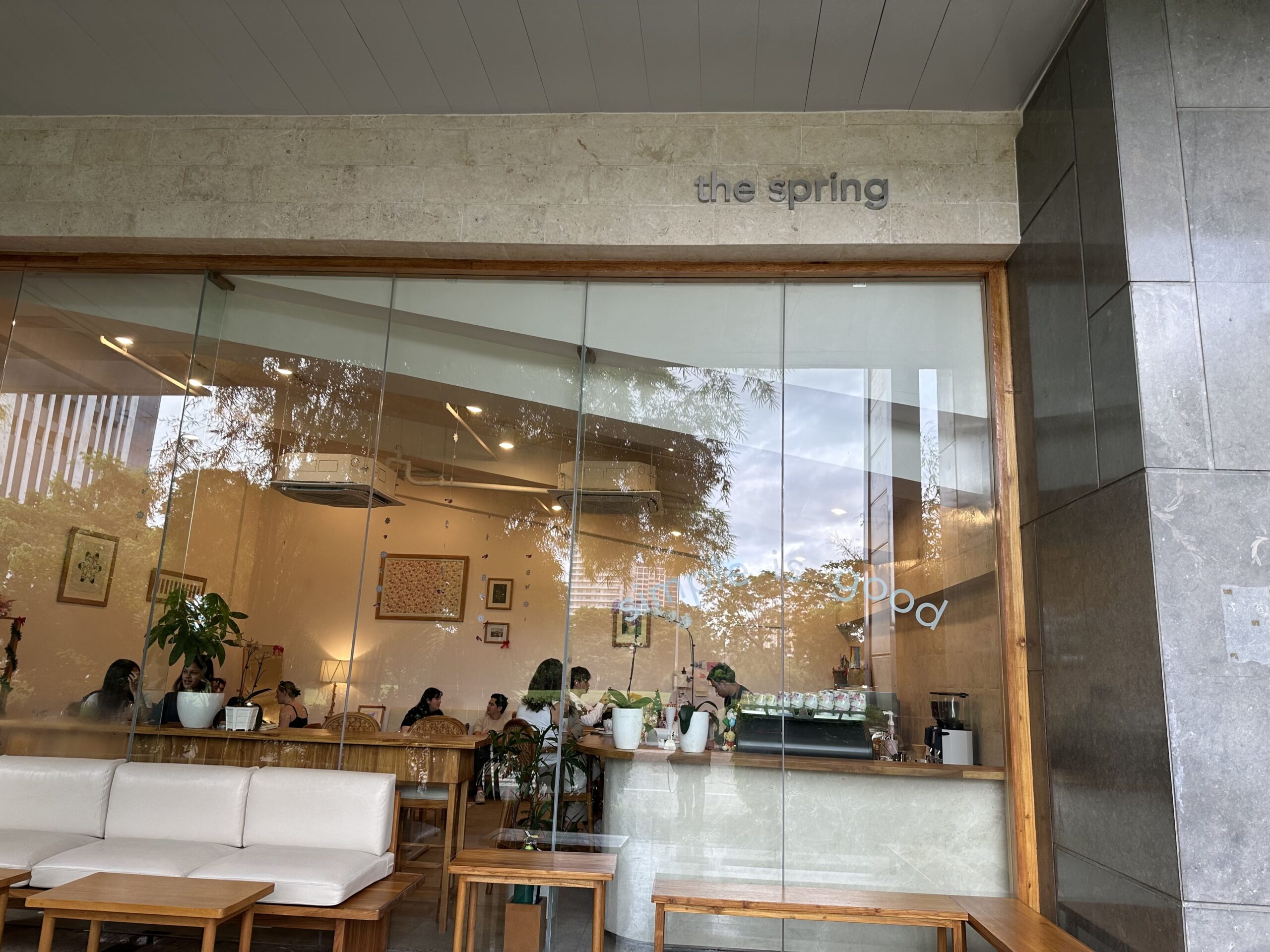
The Spring creates the perfect escape for relaxation and comfort.

Matcha latte
The first stop was The Spring, with Scandinavian-inspired interiors and a super chill vibe. A hands-on young owner, Ange Delas Penas, knows her beans well. She was behind the counter, expertly brewing using filters I had never seen before, which she said she purchased in Taiwan. Her team of trained baristas can also whip up some tasty brews, from a cortado to a matcha latte, my latest addiction.
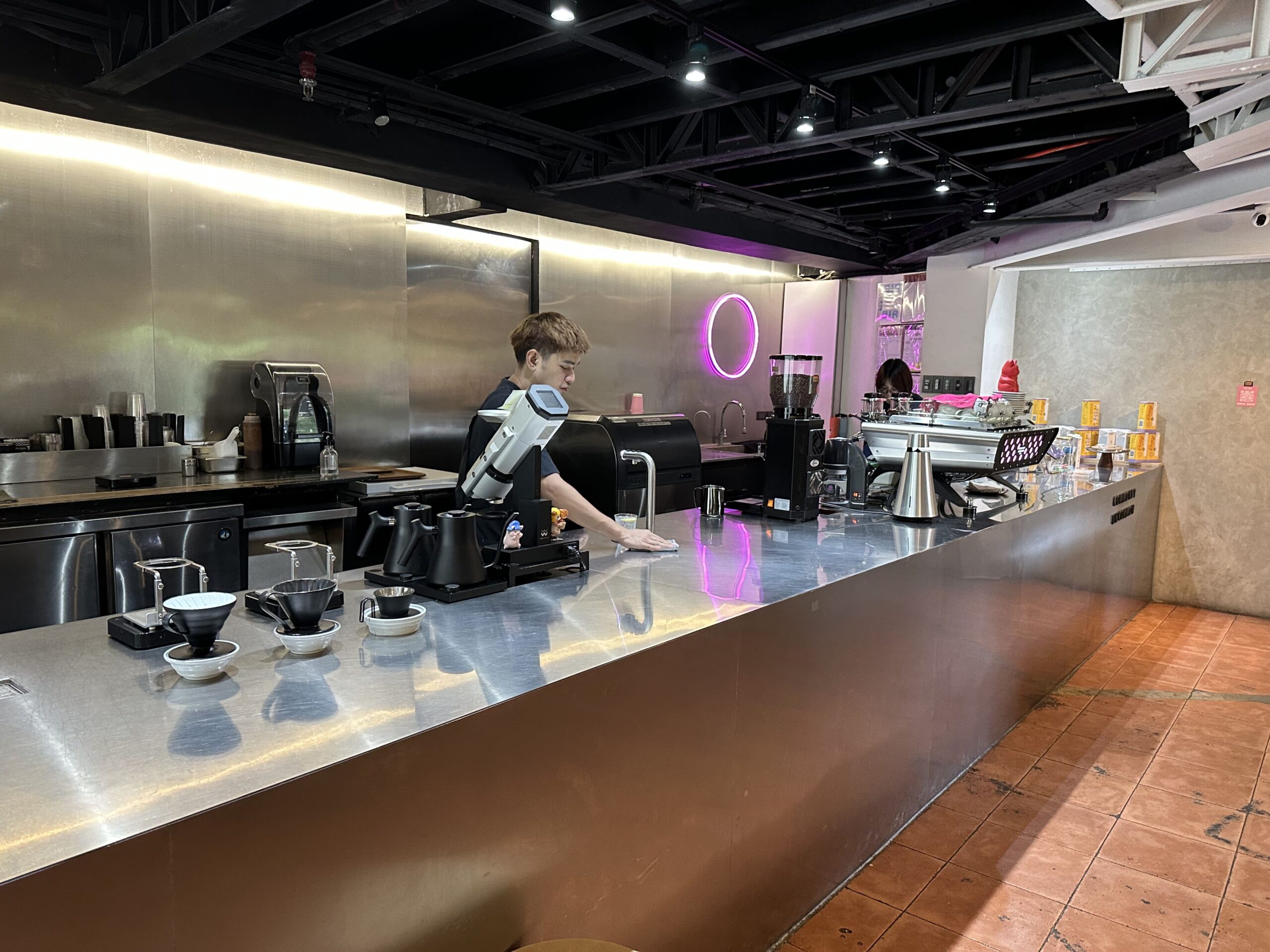
The inviting café interiors of Commonly Uncommon

Latte and espresso
Taking a different route to avoid a flash flood, we dashed out of the car into the warmth of Commonly Uncommon at Crossroads. Don’t let this non-descript, industrial vibe fool you; this java joint knows its craft. Commonly Uncommon uses single-origin beans and, like most cafes these days, also offers coffee alternatives. They are unpretentious and bent on giving the customers the specialty coffee they want, sans judgment. If you prefer oak milk or sugar or enjoy iced drinks, you get what you want. Hence, you will see diverse patronage, from those armed with laptops and headphones to office peeps grabbing a quick caffeine fix to ladies who have lunch and everyone in between.
Plus, they are the only café that thinks of customers battling hyperacidity by offering antacid sachets, which we availed before contemplating our orders.
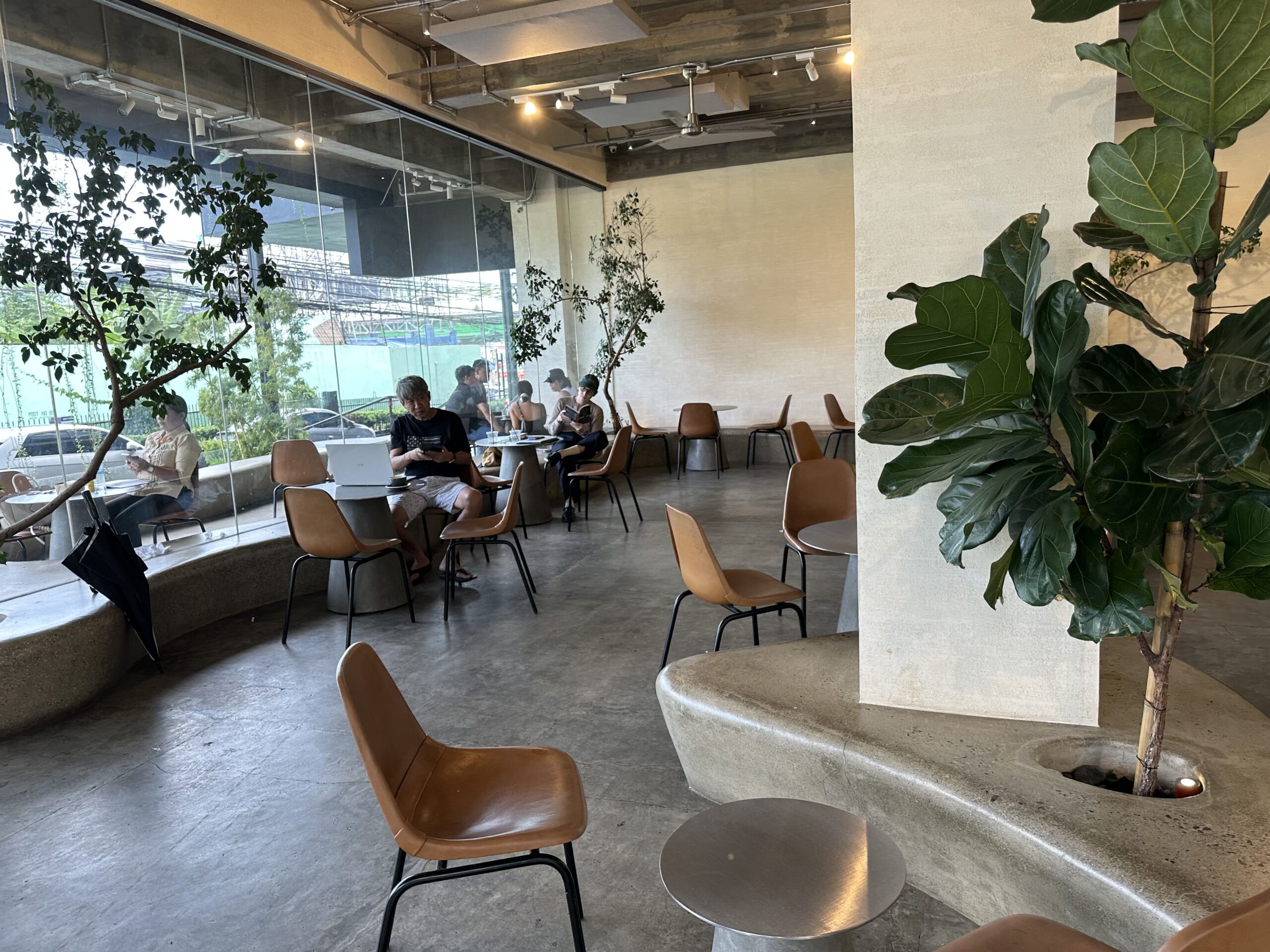
Tightrope’s laid-back interiors, designed for comfort and creativity
Our caffeine-fueled afternoon’s final stop was Tightrope in the former Henry Hotel. Tightrope is the largest of the three we visited, with the same industrial vibe that is very common these days, and tattooed baristas. Large windows ensure that it is always bright, and this is where you will certainly run into someone you know.
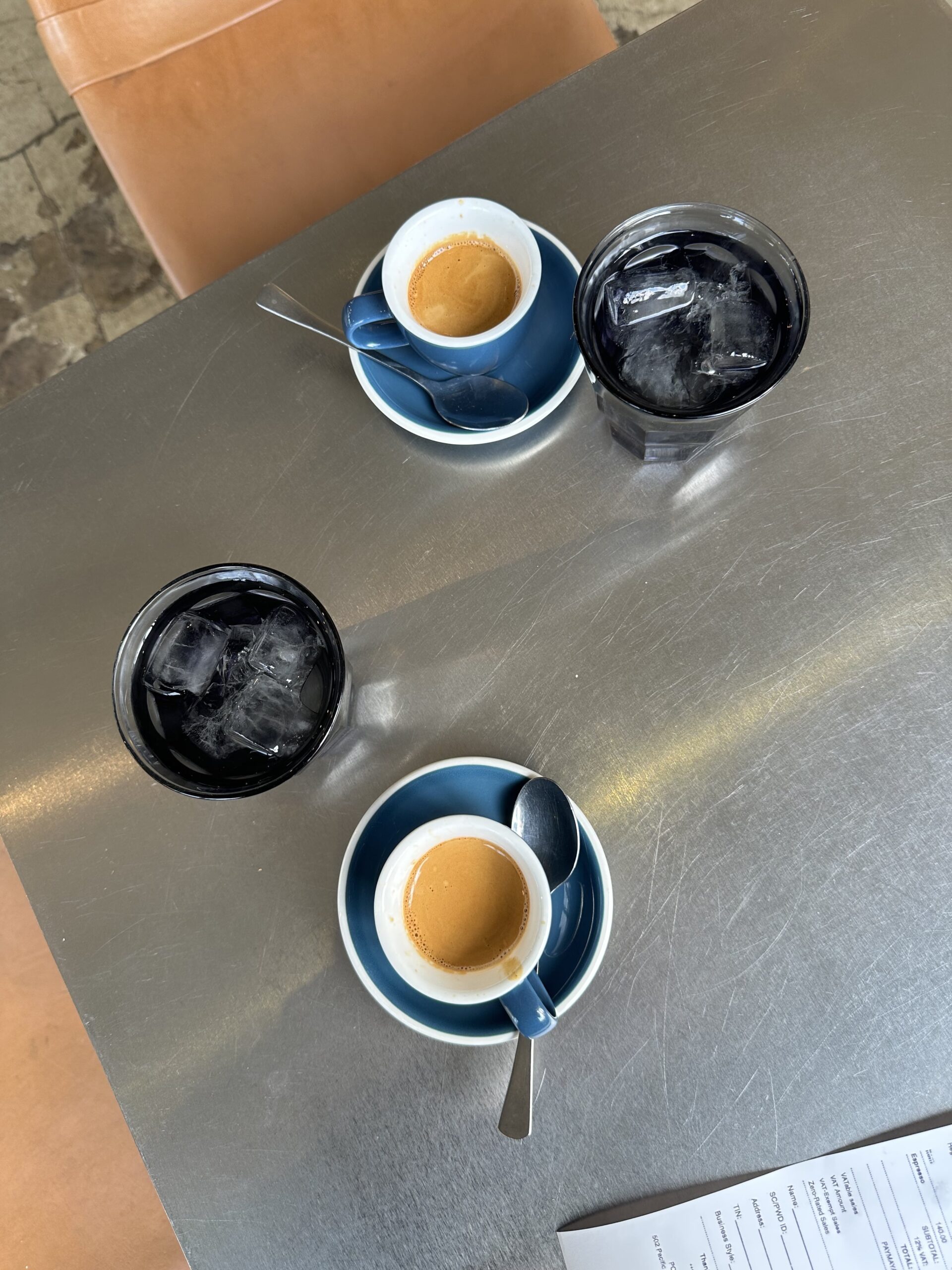
A bold and aromatic espresso shot, ready to awaken the senses.
As this was our third stop, and yes, we were ready to run a marathon after, as we were so pumped, we decided to stick to the classics and have an espresso because you can always taste the quality of a coffee in an espresso. Tightrope has a delicious burnt Basque cheesecake that can be shared, so you can also share the calories. Winding up a well-spent rainy afternoon with great coffee and gossip, we liked all three coffee shops, but Uncommonly Common really stood out.
-

 People2 months ago
People2 months agoThe Cardinals–an Amazing Gallery of Portraits on Cardinals in the Philippines by Artist Jun Impas
-

 QuickFx1 month ago
QuickFx1 month agoHill Station Baguio-Mitos Benitez-Yñiguez Raises the Bar with a Gastronomic Experience in a Cultural Heritage Building
-

 Style2 months ago
Style2 months agoFilippo Summer/Spring 2025 Menswear Collection-Fashion Designer Phillip Rodriguez Stays on Top of the Game
-

 People6 days ago
People6 days agoA Destination Wedding in Capiz; A Love Story in Focus
-

 Beauty & Wellness3 months ago
Beauty & Wellness3 months agoThe Lowdown on IV Drips–Dr. Victoria Jordan Sarmiento Opens Krowne Premiere Medical Aesthetics to Promote Overall Well-being
-

 QuickFx2 months ago
QuickFx2 months agoArt Beat–Maris Holopainen returns to the Original Qube Gallery Crossroads with a Smash Hit in Unscattered Voices
-

 Prime Target3 months ago
Prime Target3 months agoJamie Gellor–A Multihyphenate at the Intersection of Business, Beauty, and Wellness
-

 Events2 months ago
Events2 months agoSome Enchanted Evening–Marguerite Lhuillier hosts a Despidida Dinner for Eva Gullas in her Fabulous Post-Modernist Maria Luisa Mansion





















You must be logged in to post a comment Login